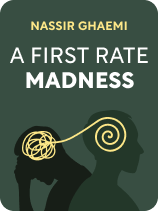

This article is an excerpt from the Shortform book guide to "A First Rate Madness" by Nassir Ghaemi. Shortform has the world's best summaries and analyses of books you should be reading.
Like this article? Sign up for a free trial here.
What is the ideal mental health? How does mental health affect leadership and politics?
The ideal mental health isn’t a cut-and-dry definition. Rather, A First-Rate Madness by Nassir Ghaemi says your perfect idea of mental health depends on your situation. And for leaders, Ghaemi claims that your mental health doesn’t need to be perfect.
Keep reading to learn more about Ghaemi’s radical idea of an ideal level of mental health.
Ideal Mental Health and Two Mental Conditions Affecting Leadership
When it comes to leadership or politics, Ghaemi argues that there’s no such thing as ideal mental health. Rather, the best level of mental health depends on the situation. In peaceful times, good mental health offers many advantages for leadership. However, in turbulent times, mental illness tends not only to produce better leaders, but good mental health can actually produce worse leaders.
(Shortform note: While Ghaemi contends that mental health may not benefit leadership, in general, good mental health benefits quality of life and physical health. Research finds that good mental health gives you a positive outlook, increases your sense of purpose, heightens the intimacy of your relationships, and leads to fewer chronic physical health problems like heart disease and diabetes.)
The reason for this, Ghaemi argues, is that mental illness puts the leader through unique struggles and experiences that enhance traits that are important for navigating sensitive crises. Specifically, leaders during crisis times must have broad perspectives and understand multiple viewpoints and be resilient and innovative in response to unpredictable and unprecedented challenges. Ghaemi identifies two mental illnesses in particular, along with their milder abnormal personality characteristics, that encourage these leadership traits.
(Shortform note: While Ghaemi mentions perspective, empathy, resilience, and innovation as important qualities for people leading in crises, he doesn’t discuss a trait that other experts deem central to crisis leadership: clear communication. During crises, experts assert that a good leader must communicate with their followers openly and honestly to ease anxieties and cultivate trust. Many of the historical leaders that Ghaemi examines, such as Winston Churchill and Martin Luther King Jr., are known for having exceptional communication skills, which may have been unrelated to their mental health struggles.)
1) Depression and Dysthymia
Depression is a mood disorder characterized by prolonged feelings of sadness as well as physical symptoms that include the need to sleep a lot or the inability to sleep, a lack of energy, and a loss of interest in many aspects of life. Ghaemi explains that this illness can seriously damage a person’s well-being, and 10% of those who suffer from it take their lives. The dysthymic personality type can be considered the milder and more persistent version of depression.
(Shortform note: While Ghaemi uses the term dysthymia, most psychologists now refer to it as persistent depressive disorder (PDD). This change occurred in the fifth edition of the Diagnostic and Statistical Manual of Mental Disorders (DSM-5), which defines PDD as having a depressed mood for most days over a period of at least two years. Additionally, while Ghaemi considers dysthymia as an abnormal personality type and not a mental illness, many psychologists consider it to be a type of depression.)
2) Bipolar Disorder and Hyperthymia
Bipolar disorder, also known as manic depression, causes people to experience alternating episodes of both depression (low mood and energy) and mania (high mood and energy). In many ways, manic episodes can be considered the opposite of depression—fast talking and unbridled thinking, high self-esteem and energy, and reduced need for sleep. Like dysthymia, hyperthymia is a personality type defined by milder yet more long-lasting manic symptoms.
(Shortform note: In An Unquiet Mind, psychologist Kay Redfield Jamison details her experiences with manic depression, which she prefers over the term “bipolar disorder.” She argues that the latter term makes the illness appear to be two distinct moods, when in reality, both manic and depressive symptoms can often occur at the same time. This form of manic depression is what psychologists call bipolar disorder with mixed features, which affects up to half of the people with this mental illness. For example, depressive episodes with mixed features might involve having mostly depressive symptoms along with some minor manic symptoms, such as fast talking and thinking.)

———End of Preview———
Like what you just read? Read the rest of the world's best book summary and analysis of Nassir Ghaemi's "A First Rate Madness" at Shortform.
Here's what you'll find in our full A First Rate Madness summary:
- How mental illness can make someone a better leader
- How leaders like Churchill and Roosevelt benefited from mental illness
- The pitfalls of being a mentally well leader during a time of crisis






